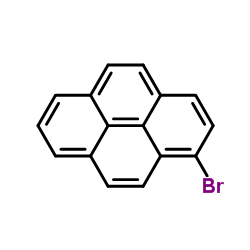Regioselective and stereoselective metabolisms of pyrene and 1-bromopyrene by rat liver microsomes and effects of enzyme inducers.
M Shou, S K Yang
Index: Drug Metab. Dispos. 16(2) , 173-83, (1988)
Full Text: HTML
Abstract
Due to the symmetrical property of pyrene (Py), trans-dihydrodiols formed at 4,5- and 9,10-positions are identical, as are the monohydroxylated products (phenols) formed at C1, C3, C6, and C8 positions. With a bromo substituent at C1 position of Py, 1-bromopyrene (1-BrPy) trans-4,5-dihydrodiol and 1-BrPy trans-9,10-dihydrodiol are distinctly different products, as are the phenolic products formed at C3, C6, and C8 positions. Products formed in the oxidative metabolism of 1-BrPy by rat liver microsomes were characterized by retention times on reversed-phase high performance liquid chromatography (HPLC), and by ultraviolet-visible absorption and mass spectral analyses. We have compared regioselective and stereoselective metabolisms at the K- and non-K-regions of Py and 1-BrPy by liver microsomes from untreated (control), phenobarbital (PB)-treated, 3-methylcholanthrene (MC)-treated, and polychlorinated biphenyls (PCB, Aroclor 1254)-treated rats. The effects of inducers on the relative amounts of non-K-region phenols formed in the metabolisms of Py and 1-BrPy by rat liver microsomes were: MC greater than PCB greater than PB greater than control. The relative order was PB greater than PCB greater than MC greater than control for the formation of both 1-BrPy trans-4,5-dihydrodiol and 1-BrPy trans-9,10-dihydrodiol in the metabolism of 1-BrPy. The ratios between metabolically formed 1-BrPy trans-4,5-dihydrodiol to Py trans-4,5-dihydrodiol, using 0.5 mg of microsomal protein per ml of incubation mixture, were between 0.4 and 0.6 in the presence of liver microsomes from untreated, PB-treated, and PCB-treated rats. However, the ratio was approximately 1.5 using liver microsomes from MC-treated rats. The ratios between the sum of 1-BrPy trans-9,10-dihydrodiol and 1-BrPy 9,10-epoxide to Py trans-9,10-dihydrodiol, and to 1-BrPy trans-4,5-dihydrodiol were in the range of 0.1 to 0.5 using four rat liver microsomal preparations. These data revealed the effects of a bromo substituent at C1 of Py on the regioselectivity of various rat liver microsomal enzymes toward the oxidative metabolism at various positions of 1-BrPy. The enantiomeric compositions of K-region dihydrodiols formed by four rat liver microsomal preparations were determined by chiral stationary phase HPLC and circular dichroism spectral analyses; the percentage of R,R-enantiomers were: Py trans-4,5-dihydrodiol, 78-79%; 1-BrPy trans-4,5-dihydrodiol, 74-77%; 1-BrPy trans-9,10-dihydrodiol, 86-97%.
Related Compounds
| Structure | Name/CAS No. | Molecular Formula | Articles |
|---|---|---|---|
 |
1-Bromopyrene
CAS:1714-29-0 |
C16H9Br |
|
Cumulative health risk assessment of halogenated and parent ...
2015-03-01 [Ecotoxicol. Environ. Saf. 113 , 31-7, (2015)] |
|
Confocal and fluorescence lifetime imaging sheds light on th...
2015-03-21 [Dalton Trans. 44(11) , 4957-62, (2015)] |
|
Synthesis and characterization of oligodeoxynucleotides cont...
2000-06-29 [Org. Lett. 2(13) , 1871-4, (2000)] |
|
Photophysical properties of symmetrically substituted diaryl...
2016-01-01 [Photochem. Photobiol. Sci. 15 , 45-56, (2016)] |
|
Structure-dependent lipid peroxidation by photoirradiation o...
2013-01-01 [J. Environ. Sci. Health. A. Tox. Hazard. Subst. Environ. Eng. 48(3) , 233-41, (2013)] |